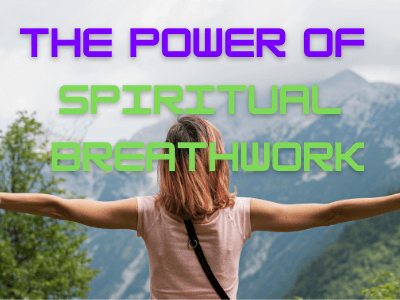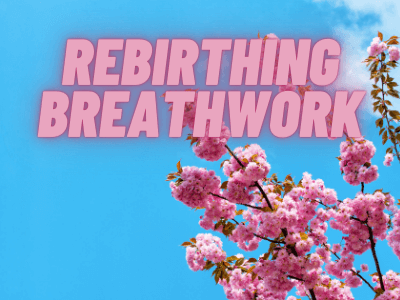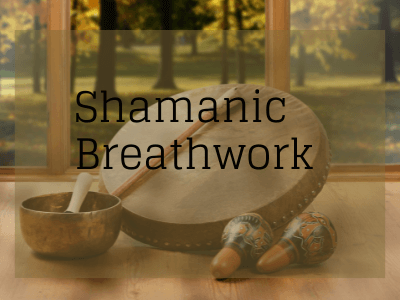The Power of Spiritual Breathwork For Spiritual Awakening
In the quest for spiritual growth and self-discovery, many individuals are turning to a powerful practice known as spiritual breathwork. This transformative technique combines conscious breathing with the intention to facilitate profound healing, expansion, and awakening.
In this article, we will explore the benefits of breathwork, and its connection to spiritual awakening, and delve into five intensely transformative types of breathwork. Additionally, we will provide six easy breathwork practices that you can engage in alone to begin your own spiritual breathwork journey.

Benefits of Breathwork:
Breathwork offers a multitude of benefits that contribute to physical, mental, and emotional well-being. By consciously manipulating the breath, we tap into the body’s innate ability to restore balance and harmony. Some of the key benefits of breathwork include:
Increased Energy and Vitality: By oxygenating the body, breathwork boosts energy levels and enhances overall vitality.
Enhanced Clarity and Focus: Conscious breathing brings clarity to the mind, improving focus, and promoting mental acuity.
Improved Physical Health: Regular breathwork practice can strengthen the respiratory system, improve lung capacity, and support overall physical well-being.
Breathwork & Spiritual Awakening:
Breathwork serves as a powerful catalyst for spiritual awakening, offering a direct pathway to higher states of consciousness. Through conscious breathing, individuals can:
Access Altered States of Consciousness:
Certain breathwork techniques induce altered states of consciousness, allowing individuals to explore realms beyond ordinary perception.
Deepen Intuition and Connection:
Spiritual breathwork opens the channels of intuition, fostering a deeper connection with oneself, others, and the universe.
Release Energetic Blockages:
By consciously breathing into areas of tension and stagnation within the body, breathwork helps release energetic blockages and promotes the free flow of life force energy.
Connect with the Divine:
Breathwork can facilitate a profound sense of unity with the divine, allowing individuals to experience a deep connection to something greater than themselves.
5 (Intensely Transformative) Types of Breathwork
Pranayama:

Pranayama, a Sanskrit term meaning “life force control,” is a cornerstone of yoga. It encompasses various breathing techniques that aim to cultivate and regulate the flow of prana, or life force energy, within the body.
Through practices such as alternate nostril breathing, kapalabhati, and ujjayi breath, Pranayama promotes physical, mental, and spiritual well-being. It calms the mind, balances energy, and brings harmony to the body, allowing individuals to tap into their spiritual essence.
Holotropic Breathwork:

Holotropic Breathwork, developed by Dr. Stanislav Grof, is a powerful approach to self-exploration and healing. It combines deep, rhythmic breathing with evocative music in a safe and supportive setting.
By inducing altered states of consciousness, Holotropic Breathwork allows individuals to access the realms of the psyche, unlocking deep-seated emotions, memories, and insights. It offers a transformative journey of self-discovery, spiritual growth, and emotional healing.
Rebirthing Breathwork:

Rebirthing breathwork focuses on releasing suppressed emotions and accessing deep states of healing and renewal. This technique involves conscious connected breathing, where the inhalation and exhalation are continuous and uninterrupted.
By oxygenating the body and stimulating the release of stagnant energy, individuals can address past traumas, overcome limiting beliefs, and experience emotional and spiritual rebirth.
Shamanic Breathwork:

Shamanic breathwork draws inspiration from ancient shamanic practices and rituals. It involves rhythmic, deep breathing accompanied by evocative music or drumming. This transformative technique allows individuals to journey into the subconscious mind, connect with spiritual realms, and access profound insights and healing.
Shamanic breathwork often involves the exploration of personal power, ancestral wisdom, and the integration of shadow aspects.
Wim Hof Breathwork:

Developed by Wim Hof, known as “The Iceman,” Wim Hof’s breathwork combines specific breathing patterns with cold exposure and mindset training. This method involves controlled hyperventilation followed by breath retention, promoting increased oxygen uptake and alkalinity in the body.
Wim Hof breathwork has been associated with improved physical and mental well-being, increased resilience, and enhanced immune system function.
Breathwork and Spiritual Healing
Breathwork and spiritual healing go hand in hand, as conscious breathing can be a potent tool for facilitating profound healing experiences on a spiritual level. Here are some ways in which breathwork supports spiritual healing:
Energetic Clearing and Balancing:
Breathwork allows individuals to release stagnant energy and clear energetic blockages that may hinder spiritual growth. By consciously breathing into areas of tension or discomfort, one can facilitate the movement of energy, restoring balance and harmony within the body, mind, and spirit.
Emotional Release and Integration:
Breathwork offers a safe space for the release and integration of suppressed emotions. Through deep, connected breathing, individuals can access unresolved emotional experiences stored within the body and gently release them. This process allows for emotional healing and a greater sense of inner peace and wholeness.
Expanded Consciousness and Spiritual Insights:
Conscious breathing can induce altered states of consciousness, opening doors to expanded awareness and spiritual insights. As individuals engage in breathwork, they may experience heightened intuition, deepened connection with their higher selves or divine presence, and a broader perspective on their life’s purpose and spiritual journey.
Connection to Higher Realms and Universal Energy:
Spiritual breathwork practices often involve connecting with higher realms or universal energy. By consciously directing the breath and intention, individuals can create a bridge between the physical and spiritual dimensions, accessing guidance, wisdom, and healing energies from divine sources.
Awakening and Expansion of Consciousness:
Spiritual breathwork practices can trigger profound states of awakening and expanded consciousness. As individuals delve into the depths of their breath and surrender to the transformative process, they may experience breakthroughs, transcendent states, and a deepening connection to their true essence. This awakening can lead to personal transformation, self-realization, and a profound sense of spiritual growth.
8 Easy Breathwork Practices That You Can Practice Alone
1. The Power of Alternate Nostril Breathing (a pranayama technique) :
Alternate Nostril Breathing, a pranayama technique rooted in ancient yogic traditions, is a powerful tool for balancing energy and cultivating a calm and focused mind.
By gently alternating the breath between the nostrils, this practice harmonizes the left and right hemispheres of the brain, enhances mental clarity, and promotes a sense of spiritual equilibrium. Through regular practice, individuals can experience a heightened sense of inner balance and a deeper connection to their spiritual essence.
2. The 4-7-8 Relaxing Breath :
Understanding the 4-7-8 Relaxing Breath Technique The 4-7-8 Relaxing Breath technique is a controlled breathing exercise that follows a specific pattern of inhalation, retention, and exhalation. It involves the following steps:
- Exhale completely through your mouth, making a whooshing sound.
- Close your mouth and inhale silently through your nose to a mental count of four.
- Hold your breath for a count of seven.
- Exhale completely through your mouth to a count of eight, again making a whooshing sound.
- This completes one breath. Now inhale again and repeat the cycle for a total of four breaths.
3. Activating the Body’s Relaxation Response:
The 4-7-8 Relaxing Breath technique works by activating the body’s relaxation response, which is governed by the parasympathetic nervous system. By elongating the exhalation and holding the breath, this breathing exercise triggers a physiological response that helps to calm the nervous system, slow down the heart rate, and relax the muscles.
Benefits of the 4-7-8 Relaxing Breath:
The 4-7-8 Relaxing Breath offers a wide range of benefits that contribute to our overall well-being:
- Stress Reduction: By activating the relaxation response, this technique helps to reduce stress levels, alleviate anxiety, and promote a sense of calm.
- Improved Sleep: The 4-7-8 Relaxing Breath can be particularly helpful in promoting better sleep. Practicing this technique before bedtime can relax the mind and prepare the body for a restful night’s sleep.
- Enhanced Focus and Mental Clarity: Regular practice of this breathing exercise can improve focus, concentration, and mental clarity, allowing us to approach tasks with a calmer and more centered mindset.
- Blood Pressure Regulation: Deep breathing techniques, such as the 4-7-8 Relaxing Breath, have been shown to help regulate blood pressure levels, contributing to cardiovascular health.
4. Incorporating the 4-7-8 Relaxing Breath into Your Routine
The beauty of the 4-7-8 Relaxing Breath is its simplicity and accessibility. It can be practiced anywhere, at any time, and is especially useful during moments of stress, and anxiety, or when you simply need to find a sense of calm.
Make it a habit to practice the 4-7-8 Relaxing Breath for a few minutes each day. As you become more comfortable with the technique, you can gradually increase the number of breath cycles.
5. Soft Belly Breathing :
Soft Belly Breathing invites individuals to reconnect with the natural rhythm of their breath and cultivate a gentle and nurturing relationship with their bodies. By focusing on deep, diaphragmatic breathing, this practice promotes relaxation, releases tension, and fosters a profound sense of groundedness and connection to the present moment. Soft Belly Breathing becomes a gateway to experiencing the spiritual essence within oneself.
6. Circular Breathing:
Circular Breathing is a dynamic breathwork technique that involves maintaining a continuous, flowing breath cycle without any pauses between inhalation and exhalation. This rhythmic and circular breathing pattern activates the body’s energy centers and promotes the free flow of life force energy.
Through Circular Breathing, individuals can unlock their inner vitality, expand their consciousness, and embark on a spiritual journey filled with exploration, growth, and transformation.
7. Visualization Breathing:
Visualization Breathing combines the power of the breath with the creative capacity of the mind. By incorporating visualization techniques during the breathwork practice, individuals can amplify their intentions, connect with their inner visions, and manifest their spiritual desires. Visualization Breathing empowers individuals to harness the power of imagination, creating a bridge between the physical and spiritual realms, and unlocking the transformative potential within.
The Technique of Visualization Breathing To practice visualization breathing, follow these steps:
- Find a comfortable position, either sitting or lying down, where you can fully relax and focus your attention.
- Begin with a few deep, intentional breaths to center yourself and bring awareness to the present moment.
- As you continue to breathe deeply, imagine a specific image or scene that aligns with your intention or desired outcome. It could be a place of tranquility, a symbol of healing, or a vision of yourself achieving your goals.
- Engage all your senses in the visualization. See the image clearly, feel its textures, hear any sounds associated with it, and immerse yourself fully in the experience.
- Allow your breath to flow naturally, but remain aware of the connection between your breath and the visualization. You can synchronize your inhalations and exhalations with different aspects of the imagery if it feels natural to you.
- Continue the practice for a few minutes, maintaining focus on the visualization and allowing it to deepen and evolve.
8. Square Breathing:
Square Breathing, also known as Box Breathing, is a structured breathwork technique that follows a four-fold pattern of inhaling, holding the breath, exhaling, and holding again, each for an equal count. This balanced and controlled breathing practice cultivates inner harmony, promotes mental clarity, and anchors individuals
Final Thoughts:
Embarking on a journey of spiritual breathwork is an invitation to explore the depths of your being, connect with your spiritual essence, and unleash your true potential. Through conscious breathing techniques like alternate nostril breathing, the 4-7-8 Relaxing Breath, soft belly breathing, circular breathing, visualization breathing, and square breathing, you can tap into the transformative power of your breath.
Spiritual breathwork offers a path to healing, self-discovery, and spiritual awakening. It allows you to release stagnant energy, integrate emotions, expand consciousness, and connect with the divine. With each breath, you have the opportunity to access higher states of awareness, gain clarity, and experience profound inner shifts.
Remember, breathwork is a personal journey, and it’s important to approach it with curiosity, openness, and respect. Find a safe and supportive environment, seek guidance from experienced facilitators, and allow yourself to surrender to the wisdom and guidance of your breath.






